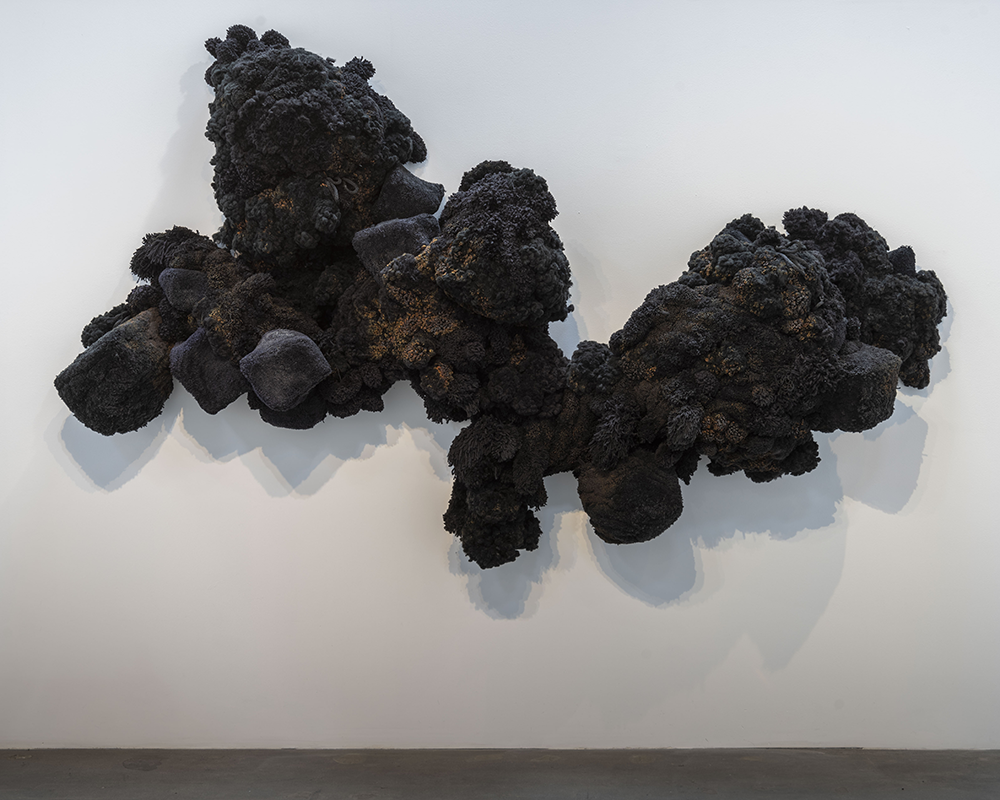Mary Brøgger RoseGallery

Untitled (low folding seat), 2021.
After remaining indoors for over a year, it’s refreshing to be confronted with the idea of the natural passage of time in the outside world—how life consciously accumulates and mutates, even when we aren’t there to watch it happen. Mary Brøgger’s retrospective exhibition “Altercation,” a small survey of her textiles, fiber art, and sculpture (all works mentioned 2021) illustrates this essential. Brøgger uses wool, acrylic yarn and cotton gauze not as the building blocks of garments and rugs—as human-cultivated applied arts—but rather to emulate living organisms like coral, moss and algae that represent nature in uncontrolled form.
Indication, a felted wool wall hanging, quickly gets at this theme. Where a work with these materials might have a repeating pattern or pictorial motif, the artist uses patchy blues, whites, yellows and grays abstractly, suggesting wispy clouds drifting across the sky. In the gallery space, Indication is installed across from the plywood construction Untitled (low folding seat). You can’t sit, but you want to, and you want to be able to just look at Indication and relax, staring deeply into its beautiful nothingness.

Mary Brøgger, There and Black, 2021

Mary Brøgger, There and Black, 2021
Untitled, a massive “wool painting” (per the artist’s description), similarly illustrates the animating force that drives “Altercation”—the clash between how we think of Brøgger’s materials and how she uses them instead. The work hugs the convex corner of a temporary wall rather than lying flat, suggesting a pale ivy clinging to a building. It’s a simple choice of display, but one that speaks volumes, because Untitled ends up seeming truly alive—and live against the wishes of a civilization that would prune it back into something consciously tended.
Where Indication and Untitled evoke moving clouds and irrepressible ivy, There and Black brings the accumulative qualities of coral—the organism and the ecosystem—into play. Created out of acrylic yarn and mixed media, There and Back gives the impression of having existed forever beyond the bounds and concerns of human time, just endlessly attaching thin yellow crusts of paint to its black surface of simulated polyps and anemones.
While the ceramic works in “Altercation” are a little out of step with the show’s theme in that they don’t reference the passage of time, or of changing nature, in any particular way, Untrodden works perfectly within the overall context of “Altercation” by attempting to falsify its premise. Placed on the gallery floor, Untrodden consists of a large swatch of sickly gray-green industrial carpet. Unlike moss, or algae, or coral, this carpet is not alive, and was never alive, and will never decay in anything resembling real time. Rather, the consciously artificial Untrodden will meet its end only when the last Twinkie on Earth goes stale.
For all the intricate production present in “Altercation,” this body of works shines in how unconstructed it truly seems. Like lichen spreading over the side of a rock, they appear to have the potential to grow and change and thrive beyond the purview of human eyes, hands, and imagination.

